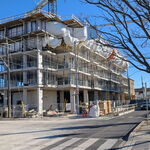One study I found in a quick Google scan suggested that underbody drag accounts for perhaps 15% of the total aerodynamic resistance of a high speed train. This compares with up to 30% for a highway trailer - which is why one does see skirts on highway vehicles.
Of the 15%, about half was attributed to the trucks, which is unavoidable especially given that the trucks and suspension have to be designed for function and are impossible to streamline. Merely skirting the underfloor equipment (which again has to be built for function) is not a satisfactory solution to the problem because the flat front-facing and rear-facing surfaces of HVAC units, retention tanks, and brake gear are not addressed.
So while the Brightline may look nicer, I doubt there are big energy gains, particularly at the less than high speed velocities that VIA runs at on shared trackage.
Interestingly, a much higher amount of drag can be reduced by using full-width diaphragms that cover the gaps between coaches. And the front and rear end shaping is paramount, at least according to this author.
- Paul




